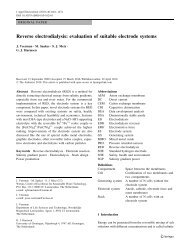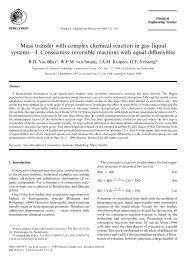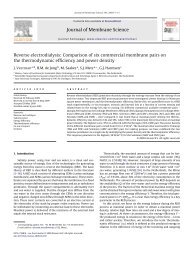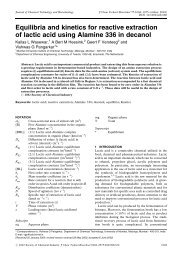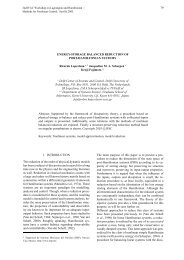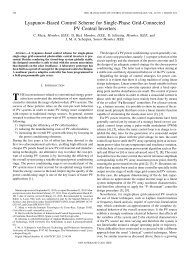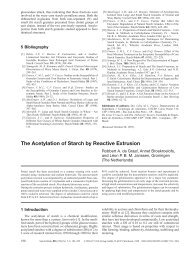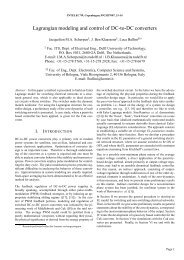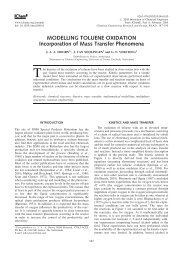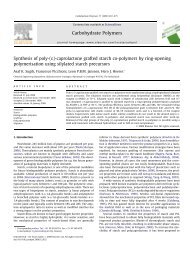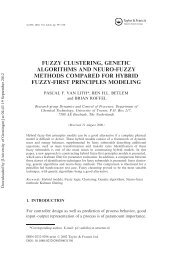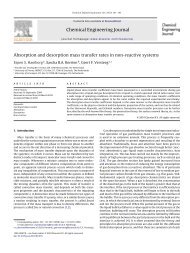Discrete exterior geometry approach to structure-preserving ... - ITM
Discrete exterior geometry approach to structure-preserving ... - ITM
Discrete exterior geometry approach to structure-preserving ... - ITM
Create successful ePaper yourself
Turn your PDF publications into a flip-book with our unique Google optimized e-Paper software.
1522 M. Seslija et al. / Journal of Geometry and Physics 62 (2012) 1509–15316. Matrix representations for linear port-Hamil<strong>to</strong>nian systems on a simplicial complex and error analysis<strong>Discrete</strong> <strong>exterior</strong> calculus can be implemented using the formalism of linear algebra. All discrete k-forms can be s<strong>to</strong>redin<strong>to</strong> a vec<strong>to</strong>r with entries assuming the values that those forms take on the ordered set of k-simplices. The boundary opera<strong>to</strong>ris a linear mapping from the space of k-simplices <strong>to</strong> the space of (k − 1)-simplices and can be represented by a sparsematrix containing only ±1 elements, while the <strong>exterior</strong> derivative is its transpose. There is a number of different Hodge starimplementations, but the so-called mass-lumped is the simplest, with the Hodge star being a diagonal matrix.6.1. Matrix representations of linear opera<strong>to</strong>rsAny discrete differential form α k ∈ Ω k(K) d is uniquely characterized by its coefficient vec<strong>to</strong>r ⃗α ∈ Λk , where Λ k =R N k , Nk = dimΩ k(K) d is the number of k-simplices. Similarly, for a ˆβ i ∈ Ω n−kd(⋆ i K) the vec<strong>to</strong>r representation is ⃗β i ∈Λ n−k = R N k. Representing discrete forms by their coefficient vec<strong>to</strong>rs induces a matrix representation for linear opera<strong>to</strong>rs(see e.g. [13,27]).The <strong>exterior</strong> derivative d : Ω k k+1d(K) → Ωd(K) is represented by a matrix D k ∈ R N k+1×N k, which is the transpose of theincidence matrix of k-faces and (k + 1)-faces of the primal mesh [13,30]. The discrete derivative d : Ω k k+1d(⋆K) → Ωd (⋆ i K)in the matrix notation is the transpose of the incidence matrix of the dual mesh denoted by ˆD ∈ RN k+1 ×N k,which can be, as.we shall soon show, decomposed as ˆD = (Di .. Db ) t with D i and D b being matrix representations of d i and d b , respectively.The <strong>exterior</strong> product ∧ : Ω k n−kd(K) × Ωd(⋆ i K) → Ω n d (V k(K)) between α ∈ Ω k(K) d and ˆβ ∈ Ω n−kd(⋆ i K) can be written as⟨α ∧ ˆβ, K⟩ = ⃗α t W n−kk⃗β = (−1) k(n−k) ⃗β t W k⃗α n−k= (−1) k(n−k) ⟨ ˆβ ∧ α, K⟩,where W n−kk, W k∈ n−k RN k×N kand W n−kk= (−1) k(n−k) ( Wkn−k )t .A crucial ingredient for supplying the result of Theorem 4.2 is a discrete summation by parts formula (3.1), which in thecontext of the simplicial Dirac <strong>structure</strong>s can be rewritten as⟨de p ∧ ê q , K⟩ + (−1) k−1 ⟨e p ∧ (d i ê q + d b ê b ), K⟩ = ⟨e p ∧ ê b , ∂K⟩,where e p ∈ Ω k−1d(K), ê q ∈ Ω n−kd(⋆ i K), ê b ∈ Ω n−kd(⋆ b K) for q = k and p = n − k + 1.Representing the discrete forms by the corresponding coefficient vec<strong>to</strong>rs ⃗e p ∈ Λ k , ⃗e q ∈ Λ n−k , ⃗e b ∈ Λ b,n−k , ⃗ fp ∈Λ n−k+1 , ⃗ fq ∈ Λ k , ⃗ fb ∈ Λ k−1bgives rise <strong>to</strong> the matrix representation of (6.1) D k−1 t ⃗e p Wn−kk⃗e q + (−1) k−1 ⃗e t p W n−k+1k−1 Dn−ki⃗e q + D n−kb⃗e b = T k−1 t⃗e p Wn−kb,k−1 ⃗e b.Here the matrix T k−1 dim Λk−1×N ∈ R b k−1is a trace opera<strong>to</strong>r of (k−1)-forms on the boundary of the primal simplicial complex K .After regrouping we have D ⃗e t k−1 tp Wn−kk+ (−1) k−1 W n−k+1k−1D n−ki⃗e q + (−1) k−1 ⃗e t p W n−k+1k−1D n−kb⃗e b = T k−1 t⃗e p Wn−kb,k−1 ⃗e b.Choosing W n−kkD n−ki= I Nk , W n−k+1k−1= (−1) k D k−1 t,= I Nk−1 and W n−k = b,k−1 I dim Λ k−1 implies the well-known relation [30]bwhile interestingly enough the dual boundary opera<strong>to</strong>r is a dual of the primal trace opera<strong>to</strong>rD n−kb= (−1) k−1 T k−1 t.The discrete Hodge opera<strong>to</strong>r ∗ : Ω k n−kd(K) → Ωd (⋆ i K) has the following matrix representation [13,30]M k ⃗α = ⃗β with M k ∈ R N k×N kfor ⃗α ∈ Λ k , ⃗β ∈ Λ n−k ,while the discrete Hodge star from Λ n−k <strong>to</strong> Λ k can be described byM n−k ⃗β = M n−k M k ⃗α,where M n−k M k = (−1) k(n−k) I Nk . As in the continuous theory, the discrete Hodge opera<strong>to</strong>rs are invertible. The norm of⃗α ∈ Λ k induced by the discrete Hodge star is∥⃗α∥ 2 = ⃗α t Λ k M k ⃗α = (M k ) 1 2 ⃗α .



